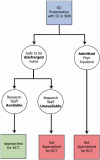Recruitment of adolescents with suicidal ideation in the emergency department: lessons from a randomized controlled pilot trial of a youth suicide prevention intervention
- PMID: 32928140
- PMCID: PMC7490899
- DOI: 10.1186/s12874-020-01117-5
Recruitment of adolescents with suicidal ideation in the emergency department: lessons from a randomized controlled pilot trial of a youth suicide prevention intervention
Abstract
Background: Emergency Departments (EDs) are a first point-of-contact for many youth with mental health and suicidality concerns and can serve as an effective recruitment source for randomized controlled trials (RCTs) of mental health interventions. However, recruitment in acute care settings is impeded by several challenges. This pilot RCT of a youth suicide prevention intervention recruited adolescents aged 12 to 17 years presenting to a pediatric hospital ED with suicide related behaviors.
Methods: Recruitment barriers were identified during the initial study recruitment period and included: the time of day of ED presentations, challenges inherent to study presentation, engagement and participation during an acute presentation, challenges approaching and enrolling acutely suicidal patients and families, ED environmental factors, and youth and parental concerns regarding the study. We calculated the average recruitment productivity for published trials of adolescent suicide prevention strategies which included the ED as a recruitment site in order to compare our recruitment productivity.
Results: In response to identified barriers, an enhanced ED-centered recruitment strategy was developed to address low recruitment rate, specifically (i) engaging a wider network of ED and outpatient psychiatry staff (ii) dissemination of study pamphlets across multiple areas of the ED and relevant outpatient clinics. Following implementation of the enhanced recruitment strategy, the pre-post recruitment productivity, a ratio of patients screened to patients randomized, was computed. A total of 120 patients were approached for participation, 89 (74.2%) were screened and 45 (37.5%) were consented for the study from March 2018 to April 2019. The screening to randomization ratio for the study period prior to the introduction of the enhanced recruitment strategies was 3:1, which decreased to 1.8:1 following the implementation of enhanced recruitment strategies. The ratio for the total recruitment period was 2.1:1. This was lower than the average ratio of 3.2:1 for published trials.
Conclusions: EDs are feasible sites for participant recruitment in RCTs examining new interventions for acute mental health problems, including suicidality. Engaging multi-disciplinary ED staff to support recruitment for such studies, proactively addressing anticipated concerns, and creating a robust recruitment pathway that includes approach at outpatient appointments can optimize recruitment.
Trial registration: ClinicalTrials.gov : NCT03488602 , retrospectively registered April 4, 2018.
Keywords: Adolescents; Clinical trials; Emergency departments; Interventions; Mental health; Pediatrics; Recruitment; Suicide; Youth.
Conflict of interest statement
The authors declare that they have no competing interests.
Figures
Similar articles
-
A suicide prevention strategy for youth presenting to the emergency department with suicide related behaviour: protocol for a randomized controlled trial.BMC Psychiatry. 2020 Jan 14;20(1):20. doi: 10.1186/s12888-019-2422-y. BMC Psychiatry. 2020. PMID: 31937274 Free PMC article.
-
Effect of a Motivational Interviewing-Based Intervention on Initiation of Mental Health Treatment and Mental Health After an Emergency Department Visit Among Suicidal Adolescents: A Randomized Clinical Trial.JAMA Netw Open. 2019 Dec 2;2(12):e1917941. doi: 10.1001/jamanetworkopen.2019.17941. JAMA Netw Open. 2019. PMID: 31860104 Free PMC article. Clinical Trial.
-
Factors associated with gender specific adolescent presentations to the emergency department for suicide risk behaviors during the COVID-19 pandemic.Clin Child Psychol Psychiatry. 2025 Apr;30(2):376-385. doi: 10.1177/13591045241307992. Epub 2024 Dec 18. Clin Child Psychol Psychiatry. 2025. PMID: 39692083
-
Behavioural mental health interventions delivered in the emergency department for suicide, overdose and psychosis: a scoping review.BMJ Open. 2024 Mar 25;14(3):e080023. doi: 10.1136/bmjopen-2023-080023. BMJ Open. 2024. PMID: 38531581 Free PMC article.
-
Emergency department management of suicidal adolescents.Ann Emerg Med. 2004 Apr;43(4):452-60. doi: 10.1016/j.annemergmed.2003.09.009. Ann Emerg Med. 2004. PMID: 15039687 Review.
Cited by
-
Engaging Red River Métis families in Manitoba in the development of child health resources - findings from a qualitative study.Res Involv Engagem. 2024 Dec 18;10(1):128. doi: 10.1186/s40900-024-00659-y. Res Involv Engagem. 2024. PMID: 39696497 Free PMC article.
-
An online survey to assess parents' preferences for learning about child health research.Nurs Open. 2021 Nov;8(6):3143-3151. doi: 10.1002/nop2.1027. Epub 2021 Aug 12. Nurs Open. 2021. PMID: 34390222 Free PMC article.
-
Increasing referrals to emergency department for psychiatric consultation and treatment among 50,056 adolescents and young adults: Predictors and implications.JCPP Adv. 2021 Jun 26;1(2):e12016. doi: 10.1111/jcv2.12016. eCollection 2021 Jul. JCPP Adv. 2021. PMID: 37431471 Free PMC article.
References
-
- Canadian Institute for Health Information. Child and youth mental health in Canada — Infographic [Internet]. 2019. Available from: https://www.cihi.ca/en/child-and-youth-mental-health-in-canada-infographic [cited 2019 4 Jun].
-
- Canadian Institute for Health Information. Care for Children and Youth With Mental Disorders. 2015. Available from: https://secure.cihi.ca/free_products/CIHI CYMH Final for pubs_EN_web.pdf [cited 2019 3 Sept].
-
- Newton AS, Rosychuk RJ, Carlisle CE, Zhang X, Bethell J, Rhodes AE. Time trends in emergency department visits for suicide-related Behaviours by girls and boys in Alberta. Can J Psychiatr. 2016;61(7):422–427.
Publication types
MeSH terms
Associated data
Grants and funding
LinkOut - more resources
Full Text Sources
Medical
Miscellaneous



